You have a talent for capturing people’s attention through your posts and reels. Maybe you’ve already earned commissions through official brand partnerships and sponsored posts. However, there’s another way content creators can make money that you might not have considered: user-generated content (or UGC).
UGC is content created by customers and advocates, not actual brand employees. This content feels genuine and natural: real people vouching for these products, giving first impressions, and honest product feedback. For brands, UGC offers a powerful way to connect to potential customers on a personal level.
Most of this content falls under two categories—even though the content looks the same to the audience:
- Voluntary UGC comes from real customers posting about their favorite items and brands. You love the product and want to share why.
- Paid UGC works like freelance content creation. You can join a brand’s UGC program and earn money by providing content for their official pages or ad campaigns.
From skincare and cosmetics to fashion and travel, your feed is packed with user-created content—even if you don’t realize it. #UGC has more than 2.1 billion views on TikTok alone.
UGC provides the perfect way to build up your experience and portfolio and open up new ways to earn from your content. Let’s dig in.
Key takeaways
- User-generated content (UGC) creators show off products as real customers—rather than a corporate ad.
- This content type is a powerful way to boost your income as a creator.
- Focus on creating quality content and growing your portfolio over time.
- Contact your favorite brands and check social media pages for open UGC invites.
- Use powerful partnership platforms like impact.com/creator to connect with brands, agree on payment, and launch top-tier content.
UGC is made for people by people
At the surface level, UGC creators show consumers how products look and feel—sharing genuine opinions and experiences instead of a polished marketing pitch.
But it’s much more: successful UGC creators (voluntary or paid) boost the brand’s authenticity and trustworthiness. That’s why brands today love user-generated content.
People trust people, after all. And we’re more likely to believe recommendations from someone we relate to—rather than brands themselves.
Let’s face it: if we’re on the fence about buying something, we’d all rather see a hands-on demo from a real person over a slick ad.
This type of content showcases a creator’s skills and builds credibility for brands—boosting their reputation and their bottom line. It’s a win-win situation for both creators and brands.
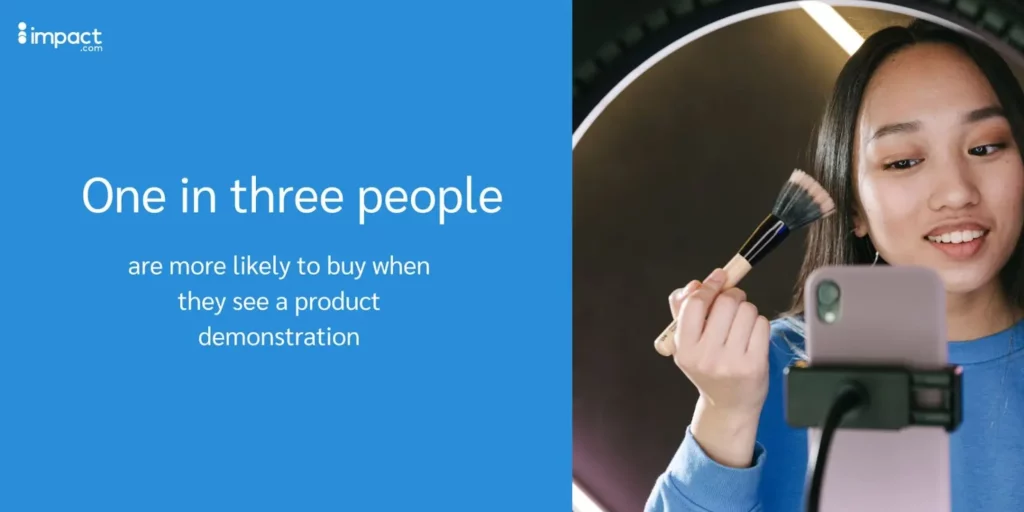
Source: The State of Influencer Marketing for Consumers in 2023
The lowdown on UGC vs. sponsored content
People with small (or even no) audiences can create UGC. So can established influencers. What separates UGC and traditional sponsored content, then?
The difference comes down to the types of content and brand partnerships:
- Sponsored content means the brand has hired you to run a campaign on your page. These collaborations are usually short-term, relying on your voice and reach to promote the products.
- With paid UGC, brands commission you for content on their channels. Your reviews and hands-on demos might be used for brand posts or native ads on Instagram and TikTok. These partnerships are ongoing and cover multiple campaigns.
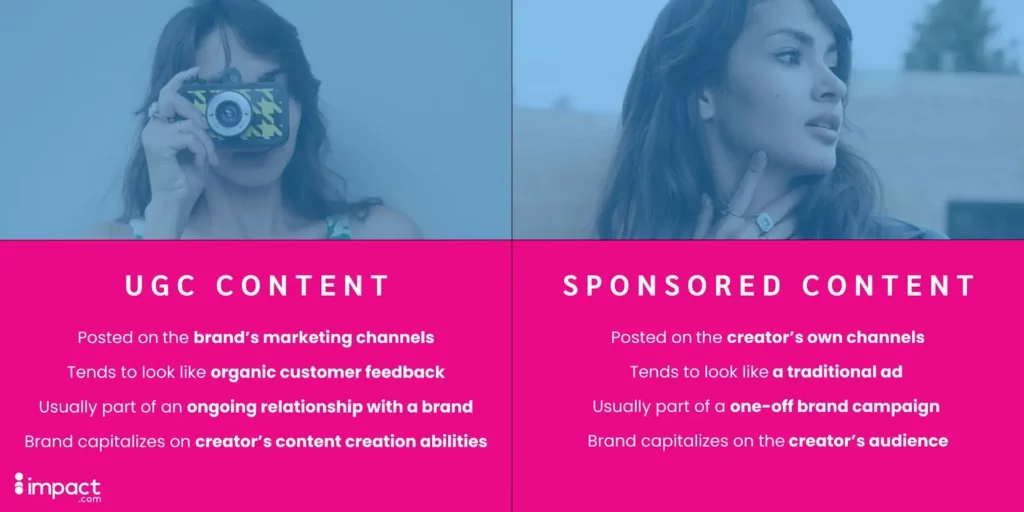
5 steps to turn UGC into a biz-generating machine
From the audience perspective, great UGC comes across as genuine customer reviews and feedback—instead of one-off brand deals. But when monetizing your content, you don’t have to lock into one or the other.
Even if you’ve created sponsored content before, offering UGC adds another income stream, opens up new opportunities with brands, and expands your creator portfolio.
Here are five important steps to get started:
1. Build a market research spreadsheet of brands and products
Understanding common UGC formats and what resonates within your niche is vital—especially if you want to set yourself apart from the competition.
Explore the content that your favorite brands showcase. Pay attention to what connects with them (and their audience) on a deeper level. If you’ve worked with a specific brand before, what kind of UGC do they share?
To capture this info, start by creating a marketing research spreadsheet.
Set up key categories as columns in your spreadsheet. You’ll focus on these areas during your research to get a well-rounded view of each brand. Some categories to consider:
- Product/service type
- Target audience
- Brand reputation
- Brand awareness
- Market demand
- Competition
- Market trends
Now, fill in the rows of your spreadsheet with the brands you’re researching.
As you gather data, start populating the relevant categories. This way, all the information you need is right at your fingertips.
Remember, this spreadsheet isn’t just for tracking—it’s also your analysis tool. Use it to paint a clear picture of the market and establish a solid knowledge base for building a solid portfolio and pitching the right brands.
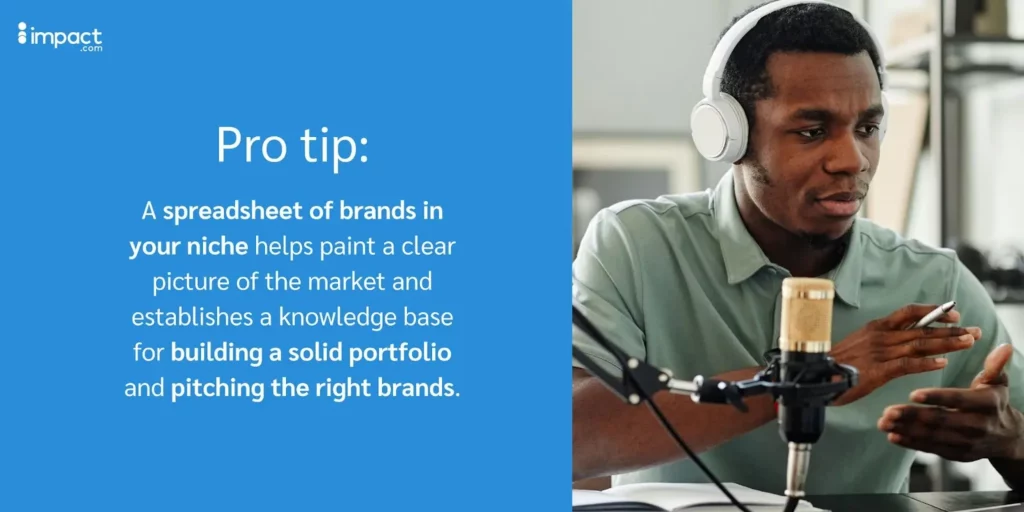
2. Craft a content strategy to attract best-fit brands
Now, put that information to good use and build a UGC portfolio.
Start by identifying brands that best align best with your goals. Look at your spreadsheet to see:
- Which brands have a similar target audience
- Which ones share your values or aesthetic
- Which are your best fit for your business goals
Next, review the type of content that works for them. Does their audience respond well to videos, images, or testimonials? Maybe there’s a high engagement rate for user-submitted photos. Take note of these successful UGC strategies.
Now, put your creativity into action to create similar but unique content. Your unique style might change from your sponsored posts—which is normal. Creating voluntary UGC will give you some practice and build up a portfolio of content you can use for pitching.
And lastly, remember to track your progress. Keep an eye on your engagement rates, check in on your hashtag usage, and always be ready to adapt your strategy based on what’s working.
3. Target brands with UGC programs
Once you have a backlog of voluntary UGC posts and clips, start contacting brands.
There’s more than one way to connect with brands looking for UGC creators:
- Look for open calls from brands on social media.
- Third-party partnership platforms (like impact.com / creator) make it easy to find compatible brands. Set custom filters, contact marketers, and start long-term partnerships all in one place.
- Reach out to your favorite brands and ask! Contact brands directly (and agencies) and share sample posts. Email is the best communication method, according to 52 percent of brands.
Since many companies want easy ways to connect with creators, use relevant hashtags on your voluntary UGC to be as discoverable as possible.

4. Let your talent shine with the perfect pitch
Most brands want creators to start the conversation—so you’ll need to take the initiative and email your pitch (and portfolio) to brands.
Your portfolio is your secret weapon. It showcases your creativity and ability to engage an audience. So, it’s gotta be front and center in your pitch.
Start by picking out some of your best voluntary UGC examples. You know, the ones that got a lot of likes, shares, or sparked conversations. These are your showstoppers—and it’ll show brands you know what you’re doing.
Next, tell a story. How did these pieces come about? What inspired them? How did your audience react? Brands love a good narrative.
Then, get specific about how you can help the brand. Maybe you’ve noticed they’re struggling with engagement or trying to reach a new audience. Use your portfolio to demonstrate how you can address these challenges.
And finally, don’t be afraid to get personal. Share why you’re excited about the opportunity to collab. Show them that you’re not just a content creator but also a fan.
As you start working with brands, make sure your creator contracts permit you to use content for self-promotion. The more you grow your portfolio, the more appealing you’ll be to brands.
Once you have a few solid client case studies, add them to a formal media kit and attach the kit to your pitch email.
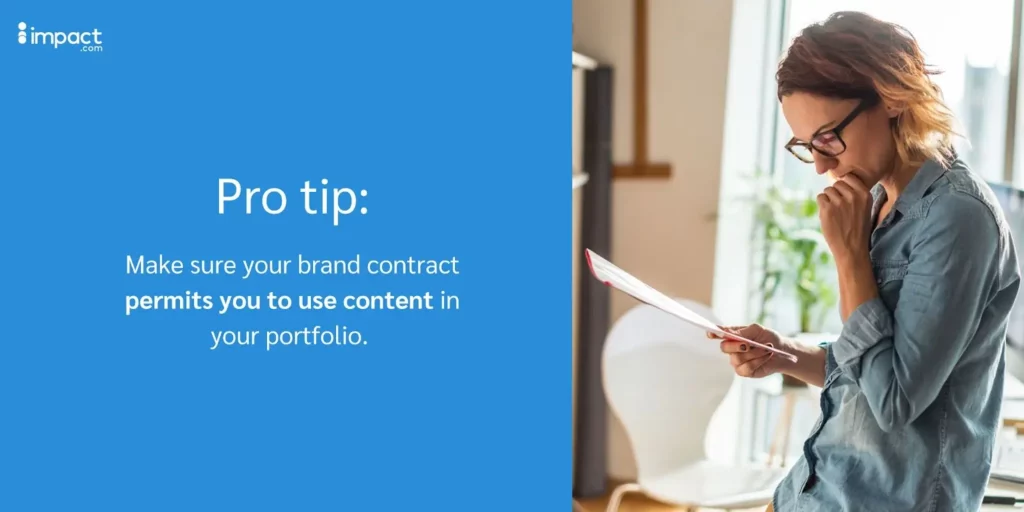
5. Level up your game by understanding audience behavior
As you move into creating UGC, new trends and products will always keep you on your toes—so keep adding to your portfolio and learning from your successes (and mistakes).
- Ask the brands you work with for performance data. Since your content shows up on their page, you won’t have access to any metrics. Requesting that actionable feedback shows brands that you care about improving and hitting their target goals—not just handing in the content and walking away.
- Add testimonials and performance metrics to your media kit. That way, you’re reinforcing your value for future brand partners.
- Don’t be afraid to keep pitching content ideas. When brands know you’re an asset to their team, they’ll want you to stick around.
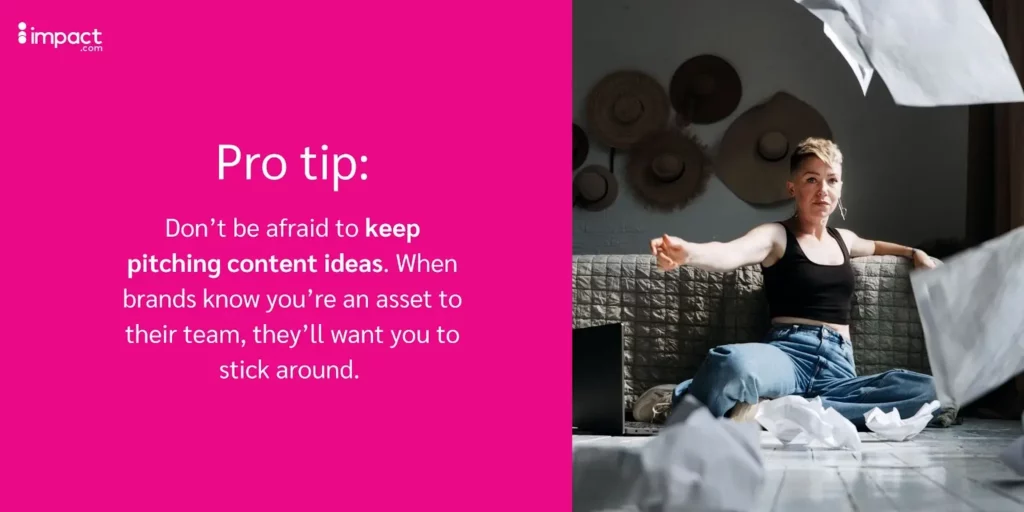
Experiment with popular UGC formats to win brand deals
UGC is about relatability, so mix up your formats and choose the best style for each product. Plus, you’ll be ready for new trends that pop up—no matter how different.
Testimonial videos build trust
Share your experience directly with the audience:
- Did the product live up to the hype?
- Would you buy it again?
- What’s the best thing about this brand?
This is probably the most common type of UGC you’ll see in your feed.
How-to videos bring products to life
Give people a breakdown of how the product or service works—especially since not everyone will know how it works or fits into their lives. This format helps people feel more comfortable taking the leap and buying/signing up.
Unboxing videos generate hype
Many creators make unboxing videos: an immersive experience that can build hype for products.
You don’t need a professional studio to make a fantastic unboxing video. Record a few different angles in a well-lit space—and let your excitement show! After all, everyone loves opening up something new.
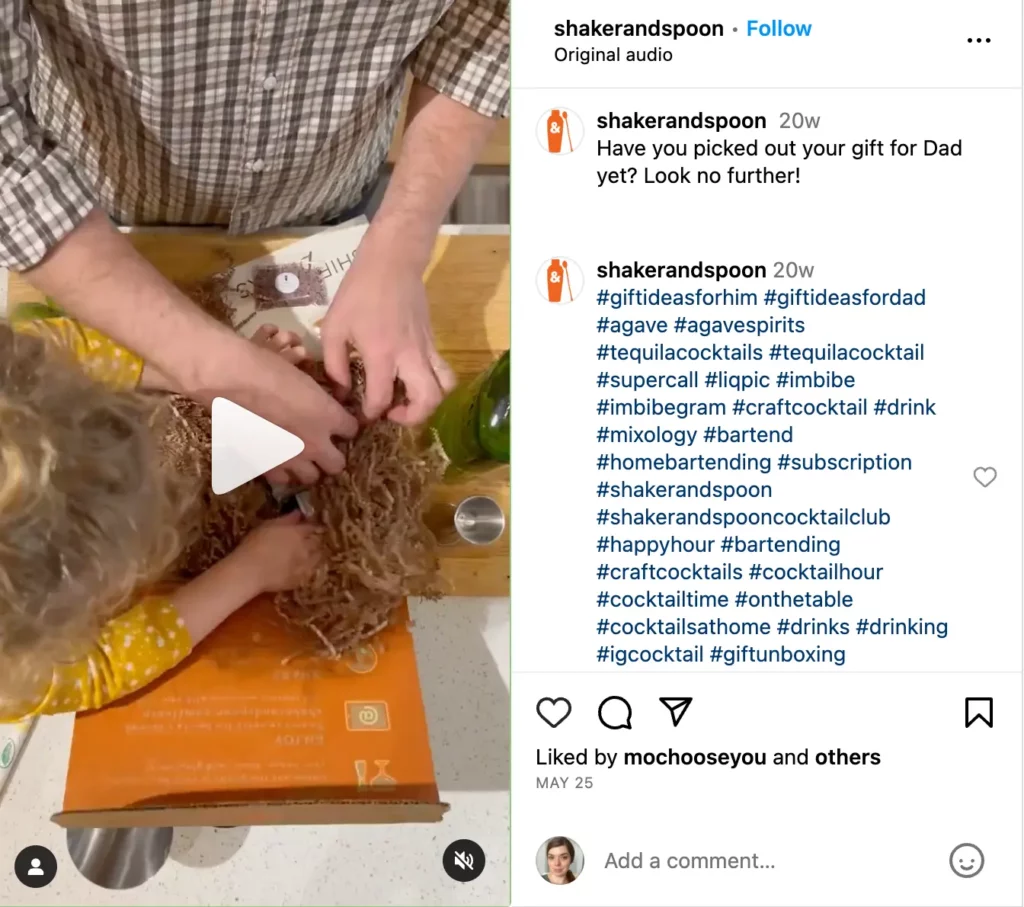
This post about Shaker and Spoon highlights a gift box for Father’s Day—showing the opening experience and exciting ingredients with a father and child.
Demo videos show products in action
While unwrapping products is always fun, what does it look like a week or a month later? How do these items fit into your daily life?
Casual demo videos are perfect for showing products in action. Keep the style natural and highlight how you use them.
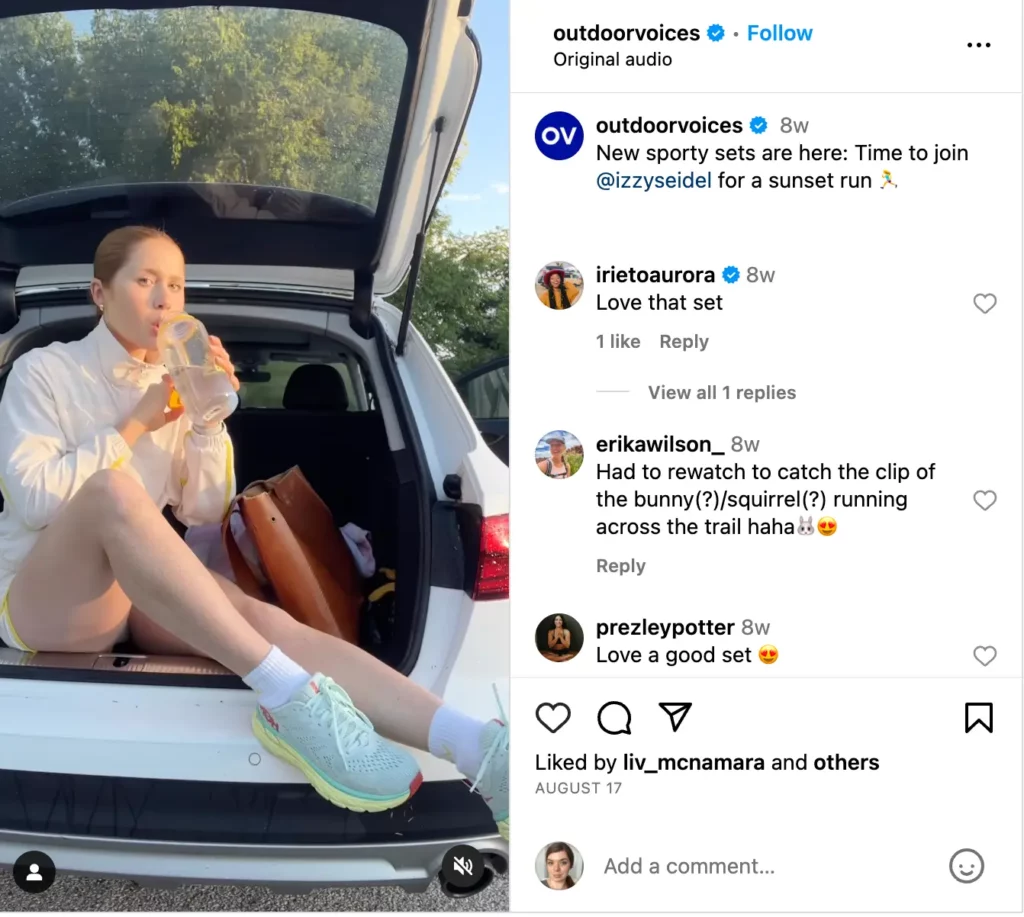
This post includes an outfit from Outdoor Voices. But the reel isn’t just focused on getting you to buy: the creator shows how they work out in the clothes.
Educational videos solve problems
Educational content gives the audience more context:
- What is this item for?
- What’s the best way to use it?
- How could it make their life better?
Show what problem you’re solving, and you’ll hold their attention.
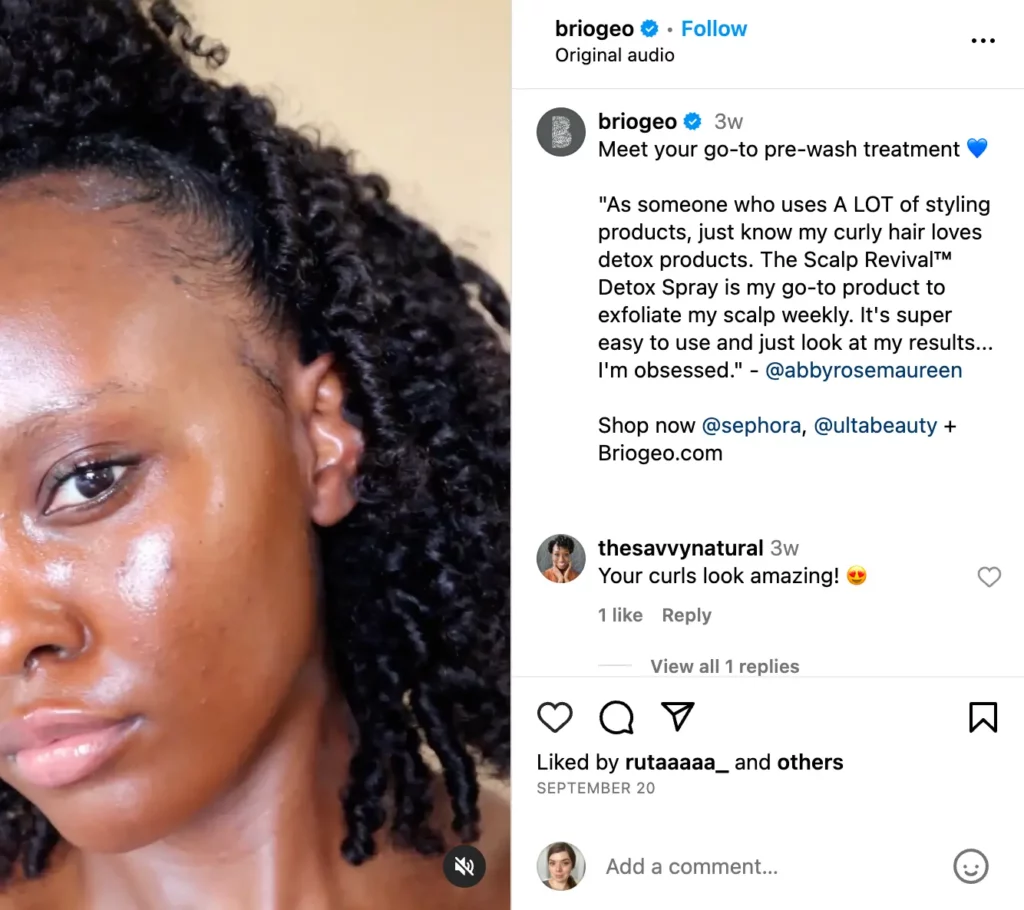
This creator shows how Briogeo’s hair products keep her scalp healthy. Educate your audience while highlighting a specific product.
Ad videos seal the deal
Some UGC lines up with more traditional ad pitches—complete with a strong call-to-action for audiences.
Boost your content with these UGC creator tools
As a content creator, you already have the essential tools you need. But as you scale up UGC projects, there are resources and strategies to help you stand out—especially if you’re branching out into this type of work alongside your regular content.
Filming your videos
You can always use a nice camera, but an iPhone is perfect for most contexts.
Like any other kind of content creation, adding a basic ring light upgrades the look and feel of each shot. And a tripod—even a small, lightweight stand—helps keep your reels clear and easy to follow. But many UGC formats work best with handheld, naturally lit shots to get that authentic look and feel.
Editing your footage
Some brand partners want fully edited videos to drop straight onto their social media pages. Others might ask for raw footage and handle editing themselves.
Instagram and TikTok give you good in-app editing tools, but having editing software on hand can be helpful:
- InShot is free to start and easy to use—but there’s a premium version to remove their watermark.
- Videoleap gives you tons of editing options on top of AI tools—plus, there’s a free trial.
Organizing your work
As you branch out and create even more content, you must stay on top of the many deadlines, promises, and plans for future content. So, make sure you have an easy way to stay organized.
Keep track of your ideas, trends, and dream brand collabs in one place with apps such as Google Keep, Apple Notes, or Evernote. Or, you can try out dedicated to-do apps such as Trello.
Partnering with brands
Tracking down brands looking for UGC creators takes time—and it’s tough to know the best way to reach out.
Make the most of the best third-party marketplaces. With the impact.com / Creator platform, you can do everything: search for brands, connect, agree on rates, see feedback, and share resources for future partnerships. This kind of purpose-built platform makes every step of the partnership process easier.
Hitting your stride as a UGC creator
UGC isn’t just for beginner content creators. It’s perfect for creators and influencers of all sizes who want to mix up their content and earn more from brands.
UGC offers a fresh way to gain experience and add to your portfolio—even if it’s just alongside your content.
So, test out different niches and topics until you find the right fit. Show off your style and audience’s reactions in your content portfolio. Connect with brands calling for creators on social media and make the most of third-party partnership platforms like impact.com / Creator.
Brands actively want to team up with passionate UGC creators. This is the type of genuine, natural content audiences are going wild for—so start sharing about what you love today!
Take a deeper dive into what it takes to collab with brands:
- What brands want: building successful creator partnerships in 2023 (research report)
- 4 research-backed ways content creators can increase buyer intent (blog)
- 5 research-backed ways creators can stand out when pitching brands (blog)
FAQs
UGC content offers an easy way to generate more income as an established content creator. It’s just a different way of working with brands.
For creators just starting out, this content type offers a lower barrier to entry. Unlike the traditional influencer model, you can start earning money immediately without a large following.
However, you must be consistent and create a portfolio, pitch brands, post content, and manage payments.
Yes, you can be a UGC creator and an influencer simultaneously.
Influencers usually create content for their pages—collabing with brands for a single campaign or set amount of time. On the other hand, UGC creators create content for brands to use on their pages (and social media ads).
You can use both types of content and brand partnerships to boost your career as a content creator.
There isn’t an exact answer here. Your rates will adapt to your experience level. Payments can range anywhere from $150 to $500 per post—some UGC creators even earn over $1,000 per post.
Your niche has an impact here, and how time-consuming each project is. As you keep building brand partnerships, use a rate card to share with brands or keep track for yourself.






